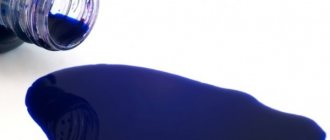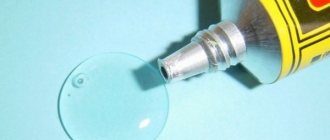Maintaining the original appearance of linoleum is not difficult, as long as it does not involve removing iodine stains.
Brown traces of this pharmaceutical product are quickly absorbed into the synthetic coating, which, if the cleaning process is delayed, leads to the need to completely replace the linoleum.
How to remove iodine from linoleum? Practice-tested methods and means will help you quickly remove stains and restore the original appearance of linoleum.
How to remove old iodine stains?
In some cases, it is not possible to remove traces of iodine that have appeared long ago. You can try to get rid of them on fabric using hydrogen peroxide and vinegar. The first is applied to a cotton swab and the contaminated area begins to be treated. Clean until the stain becomes completely light and the iodine no longer leaves traces on the tampon. Then concentrated acetic acid is applied to the stain, after which a chemical reaction begins, during which the iodine crystallizes. Solid crystals can be easily removed.
How to remove stains from your face?
There are several ways to cleanse delicate facial skin from brown iodine stains:
Fat cream
Iodine stains are generously lubricated with grease and left for five to ten minutes. After the cream has been absorbed, wipe the stain with gentle movements with a soft sponge, and treat the cleaned area of skin with facial tonic.
Laundry soap
An excellent cleanser and antibacterial agent. Suitable for treating delicate facial skin, does not cause allergic reactions.
I rub the soap in my hands until a thick foam appears. Then, carefully, without smearing it over the face, apply the foam to the spots.
As soon as the soap foam dries, it is washed off along with the stains with clean warm water.
Sea salt and bee honey
A pleasant relaxing massage with a scrub of honey and sea salt will not only cleanse the delicate skin of your face of iodine stains, but will also relax you and relieve nervous tension. To prepare the scrub, mix honey and salt in a clean container (ratio 2:1).
The resulting composition is rubbed into the skin with gentle massaging movements, then removed with a soft damp cloth, and a protective cream is applied to the face.
The skin of the face is delicate and can be easily injured. If, after applying any product, an unpleasant burning sensation, tingling or tightness appears, the cleaning procedure must be stopped immediately and the product rinsed off with warm water.
Prohibitions when cleaning
There are three “don’ts” that are worth remembering before you begin removing iodine stains from linoleum:
- Do not rub off iodine stains with emery cloth (wire brush, scraper). The use of such tools will result in a hole appearing in place of the stain, and the synthetic floor covering will be completely damaged.
- You cannot use two or more types of cleaning products at the same time. It is unknown how such a “cocktail” will affect the appearance of the coating. Most often, the result of such a cleaning is completely damaged linoleum.
- Do not use chlorine bleach (White) undiluted. A highly concentrated product can make linoleum dull and change the color and structure of the coating.
Before using any previously unknown composition, it must be tested on an inconspicuous area of linoleum.
How to remove iodine stains using traditional methods
If there is dirt on the linoleum, it is recommended to wipe it off with a damp, clean cloth or napkin. This option is suitable in cases where the antiseptic has not been absorbed into the coating. You can also use folk remedies:
If there is a need to remove iodine from the sofa, you can use the following methods:
When iodine gets on a wooden table, an excellent solution would be to use the following methods:
As practice shows, fresh stains are much more effective at removing.
Removing green stains
Careless use of brilliant green causes stains to appear on the floor surface. To remove them you can use:
- nail polish remover;
- plain acetone;
- hydrogen peroxide.
Any of the selected products is applied to a prepared cotton swab, which is used to intensively scrub the stain. Rub until the green color disappears completely. After completing the procedure, the treated area is washed with a warm solution of soap and water.
Acetone
If all the tried means do not bring the desired result, it is recommended to use acetone or nail polish remover. These liquids can corrode surfaces, which can lead to discoloration of linoleum. A little acetone is applied to a swab, which is used to gently moisten the stain. It is better to avoid unnecessary movements and not put in much effort.
Every housewife knows that a stain from iodine or brilliant green is considered a real disaster. Linoleum is an artificial material, so it absorbs liquid quite quickly. The cleaning process can take a long time. The tips in the article will help you deal with these types of stains quickly and effectively.
Comet type powder
Everyone, no doubt, has cleaning powder for stoves and plumbing fixtures in their kitchen. Cleaning powder can be different: “Komet”, “Pemolux”, “Velvet”, and so on. These powders contain soda, abrasive, and alkali. Wet the problem area, sprinkle cleaning powder on it, and leave for 5 minutes. Then rub the area with a damp sponge. Your spot will disappear or become much paler.
Starch
The most economical way would be to use potatoes to remove iodine from linoleum. You need to cut the potato in half and rub it on the stain. If you have potato starch lying around on your shelf, you can use it instead of potatoes. You need to pour 1-2 tablespoons of starch onto the stain and pour water over it to get a mixture similar to thick sour cream. Then cover with a cloth and leave for 9-10 hours. After 10 hours, remove the slurry and wash the area with a sponge and soapy water.
Features of iodine removal from various surfaces
Each surface has its own specific characteristics and what may be suitable for one material is completely inappropriate for another. Many experts recommend initially using the most gentle compounds to remove dirt. If the desired effect is not achieved, you can increase the concentration or use another method.
How to remove iodine from furniture
If a situation arises as a result of which it is necessary to wipe off iodine from furniture made of plastic, varnished wood, MDF, chipboard or leather, then the first step is to wipe the furniture with a clean damp cloth. After this, you need to try to wipe off the existing mark with a regular office eraser. If the eraser does not help, you will need to use alcohol or vodka. If untreated wood was used to make furniture, then the best option is to use sandpaper.
How to remove iodine from linoleum
If iodine has been spilled on the floor, it is recommended to take appropriate action as quickly as possible. To remove an iodine stain on linoleum, first soak it with a damp cloth or paper napkin.
Then you need to take a cotton pad, moisten it with alcohol or any other strong alcoholic drink and try to wipe off the iodine. If you don’t have alcoholic drinks on hand, you can replace them with gasoline, kerosene or window cleaner.
How to remove iodine from carpet
Raw potato tubers will help remove iodine stains from carpet:
If the carpet has a long pile, then it is best to use nail polish remover or acetone. In addition, you can thoroughly sprinkle with baking soda, add a small amount of vinegar on top and leave for 11 hours, then rinse.
How to remove iodine from plastic
In such situations, you can use several methods, including:
If it was not possible to remove the stain the first time, then it is worth repeating the procedure.
How to wipe iodine off the table
Often there is a need to not only remove iodine from the carpet, but also from the table. Today you can find a large number of ways by which you can wipe off existing stains from the surface of the table. In this case, it is important to understand that the products used can cause even more damage to the table surface. Many experts advise doing nothing in such situations. This is primarily due to the fact that the countertop has a large number of protective layers, as a result of which iodine cannot penetrate deeply; in addition, this antiseptic disappears from hard surfaces on its own over time.
How to remove iodine from wallpaper
As many experts note, it is almost impossible to remove iodine from wallpaper. This is due to the fact that the antiseptic penetrates the surface thoroughly, and when it is removed, there is a possibility that the mark will become even larger. In such cases, it is recommended to re-glue the dirty strip of wallpaper or cover it with a picture or any other decorative element.
Adviсe
A few tips from experienced housewives will speed up the process of removing traces of iodine from linoleum and help maintain the appearance of the coating after cleaning.
If, in the process of removing traces of iodine, linoleum begins to lose color, you must immediately stop cleaning and rinse the treated area with clean water.
And only after that try to repeat the process of removing contamination, but using another, more gentle means.
When cleaning the floor from iodine traces, you must ensure that the cleaning agent does not get on a clean area of linoleum. Treatment of the stain begins along the edge, smoothly moving towards the center .
Methods and means for removing iodine stains from various surfaces are presented in this section.
Methods for removing iodine from the skin
In general, ordinary iodine is considered a fairly volatile substance - when applied, it is quickly absorbed, and soon the characteristic yellow spot evaporates on its own. However, there are situations when there is no time to wait for natural evaporation. For example, if drops of a medical solution got on your hands by accident, and they need to be washed off urgently, or iodine was deliberately applied to your face, but then there was a need to urgently leave the house.
You can quickly wipe off yellowness using many methods. In general, they can be divided into 3 categories.
- Treatment with soft oily compounds - oil or cream. The advantage of the method is that the skin does not suffer during the process of removing stains. But you need to take into account that oils may not be able to cope with persistent strong stains or will dissolve the yellow stain over a long time.
- Treatment with caustic chemical solutions - soda, alcohol, weak natural acid. In such cases, the iodine disappears quickly, but a negative side effect is possible in the form of dry skin or microdamage to the epidermis.
- Eliminating iodine stains using moderately aggressive household chemicals - detergents also help get rid of yellow spots in a few minutes, but they are harmful to your hands and are especially not suitable for treating your face.
Attention! Some methods use scrubbing agents to remove iodine. But there is no point in separating abrasive treatment into a separate category, since iodine is absorbed deeply into the epidermis and cannot be wiped off only mechanically
Soft scrubs are just an addition to one of the methods listed above.
Going to dry cleaning
In cases where you are not sure that you will be able to remove the stain without consequences, you can use dry cleaning services. You can find a company specializing in carpet cleaning on the Internet using the search query “carpet cleaning company” and additionally specifying the name of your city.
It is better to give preference to those companies that have been in the service provision market for a long time and have positive reviews from their clientele. Information about this can also be found on the Internet.
Most companies in the city provide services with a specialist visiting the address. The cost of treatment is based on the type and composition of the coating, as well as the size of the carpet.
In the capital, the average cost of cleaning synthetic flooring is 200 rubles per 1 m², and wool flooring is 250 rubles per 1 m². If the pile is long, then maintenance will cost more - about 400 rubles per 1 m².
If the composition of the carpet is complex, combining several types of materials, as well as cotton, viscose or silk, then processing will have a higher cost - about 800 rubles per 1 m². Many companies set a limit on the minimum order amount, for example, from 2,000 rubles. After professional treatment, not only stains are eliminated, but also a comprehensive treatment is carried out.
Carpet dry cleaning and stain removal can be done at home or taken away.
How to clean: first steps
After getting on the linoleum, it is important to remove as much as possible of the brilliant green before it is absorbed into the coating. To do this, use what is at hand:
- salt;
- sand;
- dry rag;
- paper;
- cotton pads.
The bulk substance is poured into a high mound onto the stain, and then swept onto a dustpan. Rags or paper are used dry, since the antiseptic does not dissolve in water, upon contact with which the contamination will spread even wider. Cleaning is carried out carefully and towards the center of the stain until liquid residues are completely removed.
Use fabric you don't mind throwing away
Important! Aggressive wiping with pressing movements or the use of rough abrasive surfaces that damage the linoleum are not allowed. Next, any soap solution is used, for which laundry soap, dishwashing detergent, and washing powder are mixed in hot water
After 1–2 approaches, in 80–90% of cases it is possible to remove the brilliant green completely
Next, any soap solution is used, for which laundry soap, dishwashing detergent, and washing powder are mixed in hot water. After 1–2 approaches, in 80–90% of cases, the brilliant green is removed completely.
Traditional recipes for use at home
Folk remedies will help you easily wash linoleum from rust stains.
Lemon acid
Cleaning with citric acid pulp will help quickly remove red stains from the floor covering.
Algorithm of actions:
- Dry citric acid powder is diluted with warm water to a thick paste.
- Apply with a soft sponge and gently rub the resulting product over the rust stain on the linoleum.
- The cleaned floor covering is wiped with a clean, damp, soft cloth.
Salt will help enhance the effect of citric acid. It is added and thoroughly ground in the already prepared cleaning composition.
Fresh lemon
A small piece of fresh lemon will not only help get rid of rust stains, but will also fill the room with a pleasant, refreshing aroma.
Algorithm of actions:
- cover the rust stain with a circle of fresh lemon and leave it for half an hour;
- Afterwards, wipe the linoleum with a cloth soaked in lemon juice.
Lemon juice is a gentle remedy, so to completely remove the stain, the cleaning procedure will have to be repeated several times.
How to remove with vinegar and ammonia?
A solution of ammonia and acetic acid can remove stubborn rust stains from linoleum.
Algorithm of actions:
- Dissolve 1 tbsp in 250 ml of warm water. acetic acid.
- The resulting product is generously moistened with a yellow rust stain.
- I additionally moisten the treated area with ammonia.
- The ammonia along with the stain is carefully wiped off with a soft cloth.
Work with ammonia and acetic acid is carried out only in a respirator, in a room with good ventilation. Otherwise, there is a high risk of respiratory tract burns and solvent vapor poisoning.
Kerosene
Kerosene will help remove old rust stains.
Algorithm of actions:
- the contamination is generously moistened with kerosene;
- Leave the rust stain for thirty minutes, then wash it off with clean, cool water.
Kerosene is an aggressive chemical that must be tested on an inconspicuous area (or remains) of the floor covering before application.
Baking soda
A universal folk remedy - baking soda will help you quickly get rid of traces of rust on linoleum.
Algorithm of actions:
- Baking soda is mixed with warm water to form a thick paste.
- Using gentle movements, wipe the rust stain with a soft rag or sponge with baking soda paste.
- The cleaned area of the flooring is washed off with warm water (remnants of baking soda are removed).
When mixing soda with water, you must ensure that the abrasive particles dissolve completely. Otherwise, scratches may appear on the linoleum.
Potassium salt
Remove old rust stains using potassium salt (tartar).
Algorithm of actions:
- in 2 tbsp. warm water dissolve 1 tbsp. potassium salt crystals;
- the resulting paste is applied to the stain and gently rubbed with a soft cloth or sponge;
- The already cleaned floor covering is additionally wiped with a clean damp cloth.
Work with potassium salt is carried out only with protective rubber gloves.
How to remove with carbonated water?
The secret to soda's effectiveness in fighting rust stains is simple. Sweet water (Coca-Cola is great) contains citric acid, which dissolves rust particles on linoleum.
Algorithm of actions:
- Using a spray bottle, sparkling water is sprayed onto the rust stain.
- After twenty minutes, the treated dirt is wiped off with a soft cloth or sponge.
If you don’t have a spray bottle on hand, you can simply cover the stain with a cloth soaked generously in sparkling water.
How to remove iodine from linoleum using available means
To begin with, pay attention to the means at hand. Firstly, they are more gentle, and when used, the risk of damaging linoleum is minimal. Secondly, you don’t have to buy expensive substances, but just use what you already have in your first aid kit or kitchen arsenal. Of the available means, the most common are the following:
- soda;
- starch;
- lemon or citric acid;
- ascorbic acid;
- alcohol-containing solutions.
Let's start with soda
This is a universal remedy that helps us cope with various contaminants, including iodine stains.
- Wipe the stain with warm water without rubbing it into the surface.
- Add a small amount of baking soda and moisten with water to form a paste.
- Cover with a damp cloth and leave until the soda dries completely.
- Wipe the area with a damp cloth.
- If the stain has become less noticeable, but still remains, repeat the procedure.
Soda is a very gentle product, but you also need to be careful with it, because if used incorrectly, it can cause a chemical burn, although not a strong one.
The next place is occupied by starch
Perhaps not everyone has this product in powder form, but potatoes can definitely be found in any kitchen. In the case of using powder, the procedure is similar to the previous one. If using potatoes, follow the instructions:
Cut fresh potatoes in half.- Rub the cut edge over the stain until the surface of the potato is dry.
- Then cut off this layer and wipe the linoleum with a fresh cut.
- Repeat the procedure until the stain disappears completely.
- To finish, wipe the area with a damp cloth.
On a note! It is better to take a medium-sized potato so that it is comfortable to hold in your hand.
Lemon to the rescue
We're done with vegetables, fruits come into play - lemon. This product is more expensive than potatoes. But if alkali is not able to help you remove the stain, try using acid.
When using lemon, you should also rub the area on the floor with a slice of lemon and then rinse with clean water.
On a note! It is better to use a place with a ponytail for convenience.
The next acid is ascorbic acid
If you have an ascorbic acid tablet in your medicine cabinet, it can also help remove dirt.
Crush the tablet and add water to it to form a paste.- Apply the resulting mixture onto the floor with a brush and leave.
- Remove any residue with a wet cloth.
You should be careful with this remedy, since modern medicines are often counterfeit, including ascorbic acid. Therefore, it is better to use it as a last resort.
The main causes of linoleum contamination
Linoleum most often gets dirty in high-traffic areas, such as the hallway or main room.
Iodine can get onto the floor covering only if the bottle is used carelessly. It can fall right out of your hands, drops can flow from the pipette. Pharmacy and folk remedies will help eliminate their traces. They are always at hand in the house. If you clean the surface immediately, not even the slightest trace will remain on it. You will have to tinker with old blots.
Experts, talking about how to remove stains from linoleum, pay attention to the technical features of the coating. Its front layer is covered with a film of polymers. It increases the wear resistance of the rolled material and can be soft or very hard. In any case, iodine instantly penetrates its structure and completely saturates the protective film. That is why even if you quickly wash off a stain with water, traces of it will still remain on the surface of the material. But if you know what you can use to clean stains on linoleum, you can successfully solve this problem.
Food coloring, coffee, ink and markers
Coffee that is not removed in time leaves an ingrained yellow stain. A hot drink destroys the protective layer, penetrating deeply into the floor surface. The same thing happens as a result of children's pranks, when the coating turns out to be painted with pens or alcohol-based markers. How to remove ink from linoleum? To remove stains you can use:
- Petrol;
- Kerosene;
- Camphor alcohol;
- Turpentine.
Writing with a felt-tip pen Before washing the pen from the linoleum with these products, you should protect your hands, eyes, and respiratory tract. To begin with, it is recommended to test the effect of the anti-ink cleaner on a piece of coating. To clean a felt-tip pen from linoleum, you need to apply the product to a dry cloth and then wipe off the dirt. Then you need to thoroughly rinse the flooring with warm water.
Removing iodine stains from furniture
To remove iodine stains from furniture without leaving a trace, you must:
- Soak a cotton pad in peroxide and remove the stain.
- After this, rub the stain with a cotton pad soaked in lemon juice. The acid turns the iodine into crystals, so it can be easily removed with a vacuum cleaner.
- If contamination remains, the procedure should be repeated again.
There are other methods to quickly remove iodine stains:
- Hard surfaces can be cleaned with an aspirin solution (1 capsule per 100–150 ml of water).
- Fresh stains can be easily removed with ethyl alcohol.
- The contaminated area can be treated with sodium thiosulfate, after which the fabric should be rinsed in soapy water and then in clean water.
The method for removing stains in this case will depend on what material the iodine was dropped onto. If this is a sofa upholstery, then methods for removing stains from fabric are suitable; wood and plastic have their own tricks.
Upholstery
The first step after iodine gets on the upholstery is to thoroughly rub the fabric around the stain with soap to prevent it from getting larger. After this, the contamination must be removed as quickly as possible. To do this, you can use the following tools:
- Milk. Suitable for removing stains if they have not yet dried. It is necessary to moisten the problem area with milk and wait 15 to 30 minutes. If the iodine is not completely removed, then the fabric should be cleaned with a special product for caring for upholstered furniture or carpets.
- Ammonia. Add 1 tbsp to 200 ml of water. l. three percent ammonia. You need to moisten a soft cloth in this solution and thoroughly wipe the stain, moving from the edges to the middle. Next, the solution must be removed with a wet cloth. Perhaps the problem will not disappear the first time, in which case everything will need to be repeated all over again.
- Ascorbic acid. Several tablets of ascorbic acid should be crushed into powder and dissolved in water. The solution must be applied to the problem area and wait until the stain discolors. Remove the acid with a well-moistened cloth.
- Hydrogen peroxide. To prevent the upholstery from discoloring, the stain must be thoroughly soaped. After this, wipe the material with peroxide and rinse with water. This method is suitable for light-colored fabrics.
- Acetone. Effectively fights stains, but may be too aggressive for some fabrics. Therefore, you should first test the solvent on an inconspicuous area of the upholstery - if the fabric does not fade, acetone can be used.
Wood and plastic
If a wooden table or other furniture is damaged, you should immediately use alcohol and an eraser. First, you should wipe the surface with alcohol or vodka, and then try to wipe off the stain using an eraser. If this method does not work, then you should try other means:
- Hair fixation spray. You need to spray a little varnish on the surface, rub it with an old toothbrush and wait 1-2 hours. If after this the trace of iodine turns pale, but does not disappear completely, the procedure should be repeated.
- Sodium thiosulfate. Simply put, it is a photo fixer that can be purchased at camera stores. This substance is also sold in pharmacies. They need to treat the contaminated surface and wipe it with a damp cloth.
- Vinegar. You should wipe the wood with a cotton swab dipped in 9% vinegar. The secret is that iodine reacts with acetic acid and crystallizes, after which it can be easily removed with a damp cloth.
You should try treating plastic surfaces with the following means:
- Regular soap solution. They should wipe the stained area until the stain disappears.
- 5% ammonia. Wipe the problem area.
There are many ways to remove iodine stains from different surfaces. If any remedy does not work, then do not despair. You may need to try several methods before the stain goes away.
Universal recipes
Dealing with stains on paper is difficult, since the material itself in most cases does not tolerate contact with any liquids well. The choice of product largely depends on what exactly the sheet was stained with. However, there are also universal substances that can cope with various types of pollution. Top 5 effective recipes:
- Hydrogen peroxide. With its help, you can not only remove, but also discolor the stain. For treatment, you can use pharmacy peroxide, or purchase 2 tablets of hydroperite, which are dissolved in 50 ml of warm water.
Soak a cotton swab in the liquid and carefully work it over the contaminated surface on both sides.A blank sheet of paper is placed on top and bottom so that the document appears to be sandwiched between them. Once dry, the stains will disappear.
- Whitening toothpaste. It perfectly absorbs dirt and discolors the pigment, which makes the stain on the paper especially noticeable. The paste is applied with a brush in a thin layer and distributed evenly over the surface. After 1-2 minutes, remove it with a cotton pad and allow the sheet to dry. If the contamination cannot be removed the first time, the procedure is repeated.
- Refined gasoline. It acts as a solvent so it can easily remove most types of stains. The only condition is to process only paper that does not crumble when in contact with liquid. Gasoline is applied to a cotton pad, which is carefully passed over the entire surface of the stain. If after cleaning there is a greasy mark left on it, it should be sprinkled with starch and left overnight. In the morning the powder is cleaned off.
- Acetone. When processing paper, it is better to use nail polish remover, since the concentration of acetone in it is minimal. It is applied to the dirty mark with a brush, left for 2-3 minutes, wiped with a damp cotton pad and left to dry.
- Vinegar 9%. Acid can deal with many organic and inorganic types of stains. It can be used diluted or pure. It all depends on the intensity of pollution. Vinegar is applied to a cotton pad, applied to a dry sheet for 10 seconds and lifted. If the trace disappears immediately, then stop processing. There is no need to wash off the vinegar; it will dry and disappear on its own.











